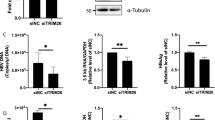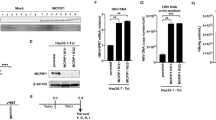Abstract
TRIM22, a tripartite-motif (TRIM) protein, is upregulated upon interferon alpha (IFNα) administration to hepatitis C virus (HCV)-infected patients. However, the physiological role of TRIM22 upregulation remains unclear. Here, we describe a potential antiviral function of TRIM22's targeting of the HCV NS5A protein. NS5A is important for HCV replication and for resistance to IFNα therapy. During the first 24 h following the initiation of IFNα treatment, upregulation of TRIM22 in the peripheral blood mononuclear cells (PBMCs) of HCV patients correlated with a decrease in viral titer. This phenomenon was confirmed in the hepatocyte-derived cell line Huh-7, which is highly permissive for HCV infection. TRIM22 over-expression inhibited HCV replication, and Small interfering RNA (siRNA)-mediated knockdown of TRIM22 diminished IFNα-induced anti-HCV function. Furthermore, we determined that TRIM22 ubiquitinates NS5A in a concentration-dependent manner. In summary, our results suggest that TRIM22 upregulation is associated with HCV decline during IFNα treatment and plays an important role in controlling HCV replication in vitro.
This is a preview of subscription content, access via your institution
Access options
Subscribe to this journal
Receive 12 digital issues and online access to articles
$119.00 per year
only $9.92 per issue
Buy this article
- Purchase on Springer Link
- Instant access to full article PDF
Prices may be subject to local taxes which are calculated during checkout





Similar content being viewed by others
References
Slomski A . WHO issues guidelines on HCV amid drug cost controversy. JAMA 2014; 311: 2262–2263.
Chevaliez S, Pawlotsky JM . HCV genome and life cycle. In: Tan SL, editor. Hepatitis C Viruses: Genomes and Molecular Biology. Norfolk: Horizon Bioscience, 2006.
Suzuki T, Aizaki H, Murakami K, Shoji I, Wakita T . Molecular biology of hepatitis C virus. J Gastroenterol 2007; 42: 411–423.
Levrero M . Viral hepatitis and liver cancer: the case of hepatitis C. Oncogene 2006; 25: 3834–3847.
Lai CL . Antiviral therapy for hepatitis B and C in Asians. J Gastroenterol Hepatol 1999; 14 Suppl: S19–S21.
Schoggins JW, Wilson SJ, Panis M, Murphy MY, Jones CT, Bieniasz P et al. A diverse range of gene products are effectors of the type I interferon antiviral response. Nature 2011; 472: 481–485.
Prens EP, Kant M, van Dijk G, van der Wel LI, Mourits S, van der Fits L . IFN-alpha enhances poly-IC responses in human keratinocytes by inducing expression of cytosolic innate RNA receptors: relevance for psoriasis. J Invest Dermatol 2008; 128: 932–938.
Xagorari A, Chlichlia K . Toll-like receptors and viruses: induction of innate antiviral immune responses. Open Microbiol J 2008; 2: 49–59.
Feld JJ, Hoofnagle JH . Mechanism of action of interferon and ribavirin in treatment of hepatitis C. Nature 2005; 436: 967–972.
Ozato K, Shin DM, Chang TH, Morse HC 3rd . TRIM family proteins and their emerging roles in innate immunity. Nat Rev Immunol 2008; 8: 849–860.
Nisole S, Stoye JP, Saib A . TRIM family proteins: retroviral restriction and antiviral defence. Nat Rev Microbiol 2005; 3: 799–808.
Barr SD, Smiley JR, Bushman FD . The interferon response inhibits HIV particle production by induction of TRIM22. PLoS Pathog 2008; 4: e1000007.
Gao B, Duan Z, Xu W, Xiong S . Tripartite motif-containing 22 inhibits the activity of hepatitis B virus core promoter, which is dependent on nuclear-located RING domain. Hepatology 2009; 50: 424–433.
Di Pietro A, Kajaste-Rudnitski A, Oteiza A, Nicora L, Towers GJ, Mechti N et al. TRIM22 inhibits influenza A virus infection by targeting the viral nucleoprotein for degradation. J Virol 2013; 87: 4523–4533.
Wakita T, Pietschmann T, Kato T, Date T, Miyamoto M, Zhao Z, et al. Production of infectious hepatitis C virus in tissue culture from a cloned viral genome. Nat Med 2005; 11: 791–796.
Zhong J, Gastaminza P, Cheng G, Kapadia S, Kato T, Burton DR et al. Robust hepatitis C virus infection in vitro. Proc Natl Acad Sci USA 2005; 102: 9294–9299.
Lohmann V, Korner F, Koch J, Herian U, Theilmann L, Bartenschlager R . Replication of subgenomic hepatitis C virus RNAs in a hepatoma cell line. Science 1999; 285: 110–113.
He Y, Weng L, Li R, Li L, Toyoda T, Zhong J . The N-terminal helix alpha0 of hepatitis C virus NS3 protein dictates the subcellular localization and stability of NS3/NS4A complex. Virology 2012; 422: 214–223.
Hattlmann CJ, Kelly JN, Barr SD . TRIM22: a diverse and dynamic antiviral protein. Mol Biol Int 2012; 2012: 153415.
Herr AM, Dressel R, Walter L . Different subcellular localisations of TRIM22 suggest species-specific function. Immunogenetics 2009; 61: 271–280.
Reymond A, Meroni G, Fantozzi A, Merla G, Cairo S, Luzi L et al. The tripartite motif family identifies cell compartments. EMBO J 2001; 20: 2140–2151.
Duan Z, Gao B, Xu W, Xiong S . Identification of TRIM22 as a RING finger E3 ubiquitin ligase. Biochem Biophys Res Commun 2008; 374: 502–506.
Yu S, Gao B, Duan Z, Xu W, Xiong S . Identification of tripartite motif-containing 22 (TRIM22) as a novel NF-kappaB activator. Biochem Biophys Res Commun 2011; 410: 247–251.
Petersson J, Lonnbro P, Herr AM, Morgelin M, Gullberg U, Drott K . The human IFN-inducible p53 target gene TRIM22 colocalizes with the centrosome independently of cell cycle phase. Exp Cell Res 2010; 316: 568–579.
Sivaramakrishnan G, Sun Y, Tan SK, Lin VC . Dynamic localization of tripartite motif-containing 22 in nuclear and nucleolar bodies. Exp Cell Res 2009; 315: 1521–1532.
Neumann AU, Lam NP, Dahari H, Gretch DR, Wiley TE, Layden TJ et al. Hepatitis C viral dynamics in vivo and the antiviral efficacy of interferon-alpha therapy. Science 1998; 282: 103–107.
Qashqari H, Al-Mars A, Chaudhary A, Abuzenadah A, Damanhouri G, Alqahtani M et al. Understanding the molecular mechanism(s) of hepatitis C virus (HCV) induced interferon resistance. Infect Genet Evol 2013; 19: 113–119.
Enomoto N, Sakuma I, Asahina Y, Kurosaki M, Murakami T, Yamamoto C et al. Mutations in the nonstructural protein 5A gene and response to interferon in patients with chronic hepatitis C virus 1b infection. N Engl J Med 1996; 334: 77–81.
Cao J, Zhou Y, Gong GZ . Effect of HCV NS5A on STAT1 phosphorylation and nuclear translocation induced by IFN alpha-2b. Zhonghua Gan Zang Bing Za Zhi 2006; 14: 894–897. Chinese.
Gong GZ, Cao J, Jiang YF, Zhou Y, Liu B . Hepatitis C virus non-structural 5A abrogates signal transducer and activator of transcription-1 nuclear translocation induced by IFN-alpha through dephosphorylation. World J Gastroenterol 2007; 13: 4080–4084.
Gale MJ Jr, Korth MJ, Katze MG . Repression of the PKR protein kinase by the hepatitis C virus NS5A protein: a potential mechanism of interferon resistance. Clin Diagn Virol 1998; 10: 157–162.
Gale M Jr, Blakely CM, Kwieciszewski B, Tan SL, Dossett M, Tang NM et al. Control of PKR protein kinase by hepatitis C virus nonstructural 5A protein: molecular mechanisms of kinase regulation. Mol Cell Biol 1998; 18: 5208–5218.
Gale MJ Jr, Korth MJ, Tang NM, Tan SL, Hopkins DA, Dever TE et al. Evidence that hepatitis C virus resistance to interferon is mediated through repression of the PKR protein kinase by the nonstructural 5A protein. Virology 1997; 230: 217–227.
Pereira AA, Jacobson IM . New and experimental therapies for HCV. Nat Rev Gastroenterol Hepatol 2009; 6: 403–411.
de Clercq E . The design of drugs for HIV and HCV. Nat Rev Drug Discov 2007; 6: 1001–1018.
Campo DS, Dimitrova Z, Yamasaki L, Skums P, Lau DT, Vaughan G et al. Next-generation sequencing reveals large connected networks of intra-host HCV variants. BMC Genomics 2014; 15 Suppl 5: S4.
Beerenwinkel N, Gunthard HF, Roth V, Metzner KJ . Challenges and opportunities in estimating viral genetic diversity from next-generation sequencing data. Front Microbiol 2012; 3: 329.
Acknowledgements
We thank R Bartenschlager for providing the CON1 replicon and T Wakita for providing the JFH1 virus. We thank Wanyin Tao, Qiang Ding, Yu Xiang and Yongfen Xu for experimental support. We thank Dahui Zhao, Shuai Yang and all of the other nurses who helped collect patient blood. We thank Shijie Sun and Jizheng He from Roche Diagnostics, China, for support with the COBAS technique. We thank Li Li and Wenjing Xuan for ordering and preparing the experimental reagents. This work was supported by a grant from the National 973 Key Project (2013CB530504), the National 863 Key Project (2012AA020103), National Science and Technology Major Projects (2013ZX10004-101-005, 2012ZX10002-007-003 and 2013ZX10004-003-003), grants from the National Natural Science Foundation of China (31030029, 31230024 and 81361120409) and by the CAS/SAFEA International Partnership Program for Creative Research Teams.
Author information
Authors and Affiliations
Ethics declarations
Competing interests
The authors of this study have no conflicts to disclose.
Additional information
Supplementary Information accompanies the paper on Cellular & Molecular Immunology's website. (http://www.nature.com/cmi).
Supplementary information
Rights and permissions
About this article
Cite this article
Yang, C., Zhao, X., Sun, D. et al. Interferon alpha (IFNα)-induced TRIM22 interrupts HCV replication by ubiquitinating NS5A. Cell Mol Immunol 13, 94–102 (2016). https://doi.org/10.1038/cmi.2014.131
Received:
Revised:
Accepted:
Published:
Issue Date:
DOI: https://doi.org/10.1038/cmi.2014.131
Keywords
This article is cited by
-
PcTrim prevents early infection with white spot syndrome virus by inhibiting AP1-induced endocytosis
Cell Communication and Signaling (2023)
-
TRIM22 suppresses Zika virus replication by targeting NS1 and NS3 for proteasomal degradation
Cell & Bioscience (2022)
-
TRIM proteins in hepatocellular carcinoma
Journal of Biomedical Science (2022)
-
On the relationship between tripartite motif-containing 22 single-nucleotide polymorphisms and COVID-19 infection severity
Human Genomics (2022)
-
Mapping of molecular interactions between human E3 ligase TRIM69 and Dengue virus NS3 protease using hydrogen–deuterium exchange mass spectrometry
Cellular and Molecular Life Sciences (2022)



